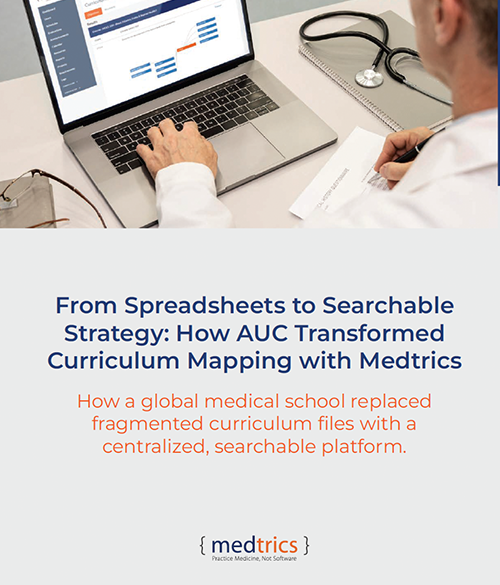Medtrics was created to be flexible and to change with the needs of the medical education community.
Edgar Poe | Director Michigan State University

How AUC Transformed Curriculum Mapping with Medtrics
AUC’s curriculum lived in siloed spreadsheets, slowing planning, obscuring coverage, and turning accreditation prep into manual detective work. Medtrics centralized, cleaned, and restructured the map into a searchable, role-based platform with live reporting. The payoff is rapid answers, confident oversight, and a foundation for longitudinal planning that scales with change.
Download Case Study
Oops! Something went wrong while submitting the form.
American University of the Caribbean School of Medicine (AUC) partnered with Medtrics to replace disconnected Excel files with a living curriculum map that faculty and leaders can search in seconds. The multi‑year initiative migrated, cleaned, and reorganized legacy data, aligning objectives, themes, and standards from the United States Medical Licensing Examination (USMLE) and the Association of American Medical Colleges (AAMC). Accredited by the Accreditation Commission on Colleges of Medicine (ACCM), AUC serves a global community of 8,500 alums with strong outcomes, including a 95% first‑time residency match rate and an 84% first‑time USMLE Step 1 pass rate from 2019 to 2023. This case study reveals how the team built transparency and speed without adding administrative burden.
Challenge
AUC’s curriculum map was locked in spreadsheets, leaving faculty without context, leadership without immediate visibility, and accreditation reporting dependent on manual cleanup during a high‑stakes curriculum refresh. Routine questions took days, duplication crept in, and strategic planning stalled.
Solution
AUC and Medtrics centralized the entire curriculum in one platform, converting objectives, USMLE references, and themes into structured, searchable metadata and delivering role‑based access with real‑time reporting. The new model enabled self‑service insight and established a single source of truth for planning and oversight.
Results
Answers that once required 2 to 14 days now arrive in under 30 seconds, with faculty autonomy up and accreditation mappings exportable on demand. Leadership can spot gaps and overlaps, verify alignment to AAMC competencies, and act on live data.
Before state.
Faculty emailed the curriculum office for basic clarity on where topics were taught and how sessions aligned to objectives. Disconnected Excel files held inconsistent labels, creating duplication and missed chances to reinforce learning. Leaders struggled to search coverage or track standards without manual effort, which slowed course updates and accreditation work. A growing redesign exposed the limits of the spreadsheet model and the need for scale.
Implementation and process.
Together, AUC and Medtrics audited legacy files, resolved duplicates, and reorganized objectives to reflect how courses actually run. USMLE‑related content became keywords and themes, making concepts like renal physiology or gene expression instantly findable, while built‑in reports surfaced unmapped sessions and framework alignment. Faculty now search by keyword, theme, or mapped objective and export results as needed.
Safeguards/compliance/oversight.
Standardized metadata and role‑based access created a single source of truth that updates continuously. Reporting supports ACCM requirements and AAMC competencies, with mappings ready for site visits and reviews, giving leaders defensible evidence without ad hoc spreadsheets. The visibility builds trust and enables faster, better decisions.
Takeaway for similar institutions.
If your curriculum lives in spreadsheets, centralized search and structured metadata can shift your team from reactive reporting to proactive oversight. The AUC story shows how to move from manual detective work to self‑service insight while laying the groundwork for session scheduling and longitudinal analysis. Get the case study to see the planning model and governance details that make the change stick.
Download the Case Study
Submit the form at the top of the page to receive a downloadable PDF. Filling out this form allows Medtrics to contact you via email.
Related Features
Interested in learning more about the solution we provided?
Check out the related features below to learn more about how
our software can meet the challenges of your organization.
Check out the related features below to learn more about how
our software can meet the challenges of your organization.
No items found.
Other Resources
Bookworms & YouTube bingers rejoice!
Check out our content collection.
Check out our content collection.
Case Study

MSPE Automation at MSU: Faster, Safer, Smarter
Discover how Michigan State University College of Osteopathic Medicine partnered with Medtrics to pilot an AI-assisted process that improved efficiency and accuracy in MSPE compilation while preserving student voice, evaluator intent, and institutional oversight
Document

24 Questions to Ask Before You Choose a Veterinary School Education Management Platform
72% of veterinary programs still rely on disconnected tools to manage scheduling, evaluations, and clinical exposure tracking. This guide helps veterinary education teams spot inefficiencies, align on their program’s most pressing needs, and ask the right questions before investing in a new platform.
Webinar

Managing Evaluations in Graduate Medical Education
9/12/2024
In an engaging and practical webinar, Natasha Brocks, owner of GME Admin Insights, teamed up with Medtrics to provide invaluable insights into managing evaluations in Graduate Medical Education (GME). Natasha’s 18+ years of experience in GME helped guide attendees through the complexities of evaluation processes, offering strategies to improve compliance, streamline workflows, and ensure the success of residency programs. Designed for GME coordinators and administrators, this session showcased how evaluation management can shape the future of medical education.
Interested in Learning More?
Oops! Something went wrong while submitting the form.

.svg)



